Since the article about wood and epoxy resin I keep getting questions about these resins. And Marian Moise's article about bar top made from ash, beer caps and epoxy resins has brought inspiration for those who want to work with epoxy resin. So I thought an article telling more about these resins would be useful. Because epoxy resins can be for wood, self-leveling epoxy flooring, concrete crack fillers, adhesives and epoxy paints. Let's see how we can manage between so many types of epoxy resins.
What are epoxy resins
Epoxy resins cover a very wide range of industrial products. There are transparent or colored, one or two-component, liquid or solid. They can be very different from each other, but they have in common reactive groups called epoxy groups which react with each other or with other types of reactive groups. Depending on their number and the groups they can react with (the hardener used) the properties of the resulting material can be very different.
I don't think I need to go into chemical explanations because more would confuse you. At one point I explained the role of the hardener in obtaining a varnish film with superior properties and many have been keen to tell me how helpful the explanation was. Let me try to make it as easy to understand as possible. Imagine a group of people dressed in white sitting next to each other. They are easy to separate, aren't they? But if they hold hands they will be harder to separate, but the image will remain monochrome. They can, however, get caught up with people from another group wearing green. The result will be another formation that's hard to separate, but it will be bi-colored and look different from the first one.
The same with resins. There may be several possible binding possibilities and several substances with which they can bind. The special properties of resins derive from the bonding of reactive groups with other groups, and their diversity arises from the possibility of bonding with different groups. It is worth noting that unbound - unreinforced - epoxy resins have very weak properties.

Uses of epoxy resins
The chemical reactions that the different types of resins have with hardeners result in products with very good adhesive properties, or with very good chemical or high temperature resistance, special electrical insulators or materials with outstanding mechanical properties. As I said, it is not only epoxy resins that, together with wood, form unique-looking tabletops.
The areas in which epoxy resins are used are manifold:
- metal coating
- electronics and electrical engineering
- manufacture of paints and adhesives
- obtaining plastics with special properties
- in construction
Epoxy paints are used indoors because they are sensitive to UV radiation outdoors (they become chalky). However, they are very good as a primer as they are resistant to corrosion and very good protection against water and moisture. This is why they are used as a primer in the automotive industry or in shipbuilding.
Epoxy adhesives are very strong and are used in many different fields: airplane, automobile, bicycle construction. They can bond wood, metal, glass, stone and some plastics. That's why when making a frame for casting a resin, it is important to bear in mind that there are very few materials to which it does not bond very well.
The most spectacular uses of epoxy resins are in flooring or in combination with wood and/or other materials. They also do a good job in construction, so let's take them one at a time.
Epoxy resin in epoxy flooring
It is the best known and most widely used resin-based flooring. It is highly resistant and durable and can be used in industrial and commercial premises with heavy traffic, not only pedestrian but also vehicular.
Because it is known as one of the most hygienic floors (it cleans very well and very easily) there was a time when all food factories, butcher shops, warehouses, hospitals, pharmacies were obliged to have such floors. I don't know if this requirement is still valid.
Thanks to its highly advanced cross-linking, the epoxy flooring is very resistant and clings very well to the concrete layer protecting it against impact, abrasion or against the action of water and chemicals.
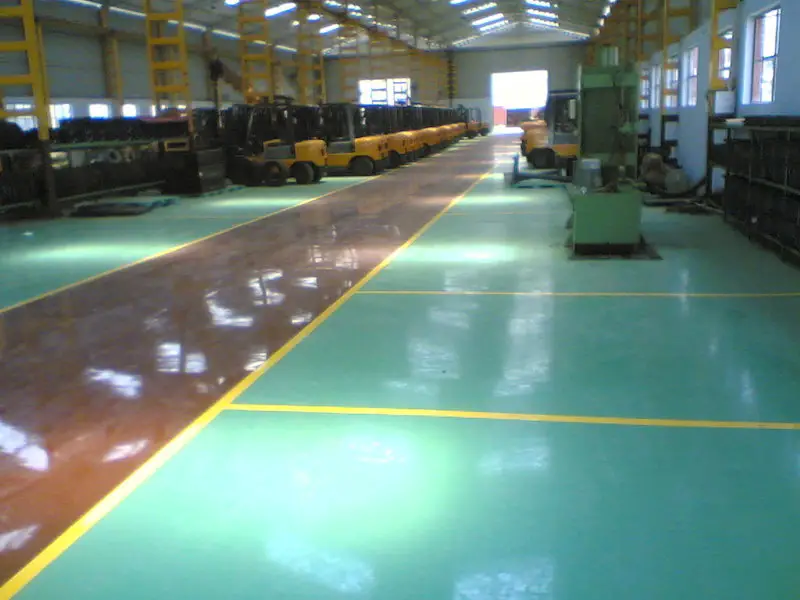
Application is by pouring - also called self-leveling flooring - resulting in a very even surface. The time to full cure is longer compared to other resin-based floors (7-10 days compared to 5 days for polyurethane), but it is also much more resistant and has very good dimensional stability. It can be used without problems in places where trucks, fork-lift trucks and other such machinery are frequently used. The disadvantage is that, if damaged, the chances of repair are very small, so total replacement is recommended.
Epoxy floors can also be used in living spaces, and the effects obtained are among the most diverse and spectacular. You can achieve metallic, marble, depth, running water and even ocean effects. For living spaces, there is the option of either cast tiles, resulting in floors thicker than 2 mm, or trafalquet tiles, with a thickness of less than 1 mm. The thicker ones are much stronger.
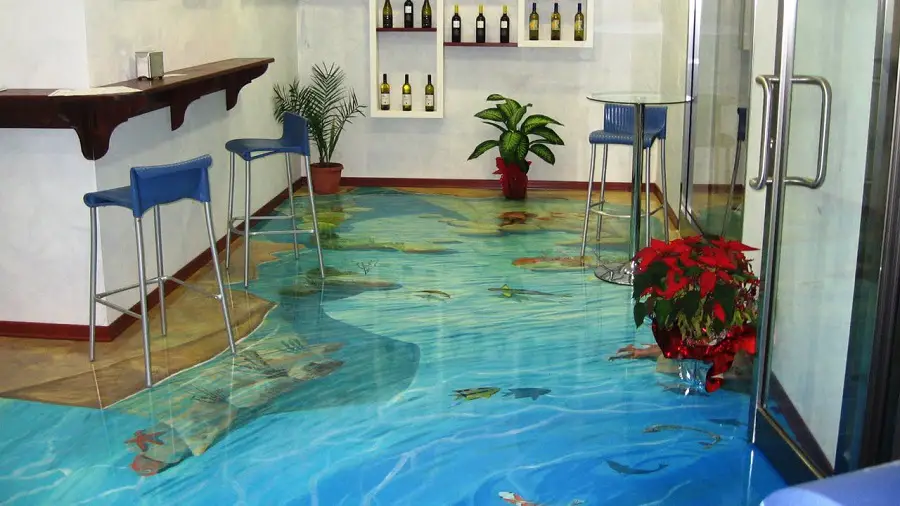
Epoxy resin used in construction
Epoxy resin is used to repair cracks or cracks in concrete. It adheres very well and the repair is very resistant over time. It can be used to repair both civil and industrial constructions.
Resin is applied into cracks by pouring or injection. Before application, the cracks must be cleaned and degreased to maximize adhesion.
Being very compatible with concrete, it can also be used for coating concrete to protect it from water infiltration or abrasion. It covers the concrete surface very well, naturally filling any voids or imperfections. After hardening, it forms a joint with the concrete, without the risk of detachment.
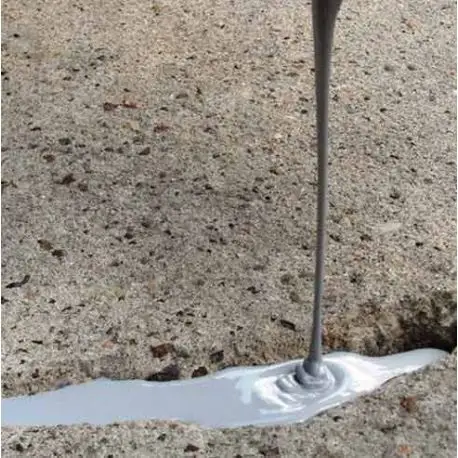
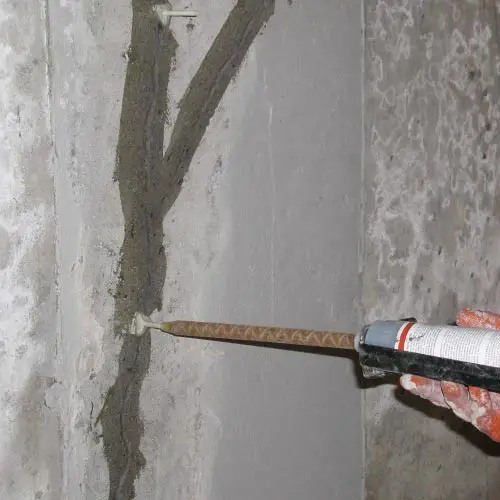
Using epoxy resin in combination with wood
In the article "Wood and epoxy resins" we have shown how to work with clear resins and a practical method for removing embedded air. The resins used for wood are clear, curing resins. They can be colored with iron oxide pigments. The same resins can also be used for jewelry.
It is very important to choose the material for the molding frame, because we have seen that resin is also a very good adhesive for materials such as metal, glass, wood or some plastics. A polypropylene frame will not react with resin.
In order not to leave bubbles in the film, the resin must be allowed to de-aerate for a while after mixing. Pouring should be done as slowly as possible to avoid entrapping air. Then heat the surface with a torch until the bubbles are completely eliminated. It is also recommended to apply successive thin coats (1 cm). There is also a special spiked tool for removing bubbles, which is commonly used for decorative floors.
If there are any surface imperfections (dust inclusions) the surface can be sanded with a very fine abrasive sponge, after which a thin coat of resin is applied with a brush. The surface will regain its shine.
It is recommended that objects embedded in resin should not be wet.
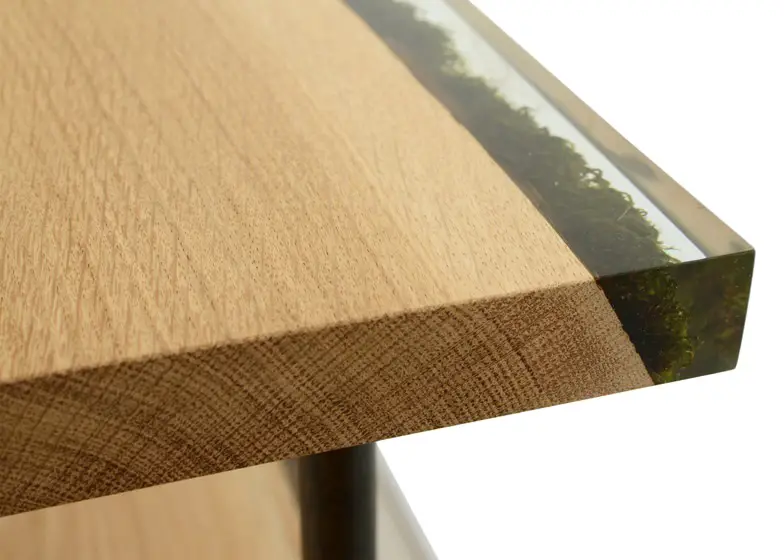
Where to find epoxy resin
There's a lot that can be said about resins so I'll come back to the subject. I also expect questions from you to make the article as useful as possible. Even if I don't know the answer I promise I will look into it so the article will contain it.
You can find these resins in specialty stores, DIY stores, online stores or from manufacturers. There are many places to find them, the important thing is to know what to ask for.
There is also a wide choice of flooring. A simple web search on the subject of 'epoxy flooring' will give you plenty of options. They can be bought in DIY or specialty stores, but it's better to call in the specialists.





































Hello
Do you think we could use epoxy resins on some walnut planks? We would like to make some window sills and a table.I think the biggest challenge is the table because if we put two planks next to each other, what do we put underneath so that the resin doesn't run through the spaces between the planks.Can you give us some advice? Where can I find resin, considering that we are from Sibiu.What is the need of resin?Thank you.
Hello.
I can say that it is quite a brave enterprise. You should start with simpler things.
You can use resin with walnut planks. The beauty of the walnut will be enhanced by the resin.
Sills should not be used outside. Resin is not UV resistant.
For the table you need to make a box of smooth, glossy melamine chipboard (no pores) so that the resin does not adhere. You can also plank and pour the resin very slowly, in batches. After each batch, blow out the air with a burner. After hardening, open the sides of the box, remove the top, sand it and wipe it with a cloth dipped in resin.
Epoxy resin can be found in DIY stores such as Hornbach, Dedeman, Practiker, etc.
To find out what you need you need to do a volume calculation: the volume of the box up to what height you want the countertop to be from which you subtract the volume of the planks.
For inspiration you have 2 links below.
All the best!
https://revistadinlemn.ro/2018/03/16/bar-din-tevi-rasina-epoxidica-frasin-si-343-de-capace-de-bere-diferite/
https://revistadinlemn.ro/2017/06/07/combinarea-lemnului-cu-rasina-epoxidica/
Don't forget to subscribe to the printed Wood Magazine! For only 58 lei/year you can find out news in the field, discover craft ideas or trade secrets. We remind you that the content in the printed magazine is different from the one on the website. Details in the link below.
Thank you!https://revistadinlemn.ro/product/abonament-revista-din-lemn/
Hello,
I want to make a coffee table out of walnut (one piece) and epoxy resin.
Please tell me when to apply oil or varnish (I haven't decided yet) on the wood, before or after the resin?In what order should they be finished?
I figure I can mess it up when sanding resin or wood.
Thank you.
Hello!
Apply the oil or varnish after applying the resin. Sand and roughen the wood before pouring the resin. After it has hardened, also sand the resin with fine sandpaper. Apply oil or varnish after sanding. If you use oil, after the wood has absorbed (30-45 minutes), wipe the surface thoroughly with a soft, clean cotton cloth.
Good luck!
https://revistadinlemn.ro/2017/06/07/combinarea-lemnului-cu-rasina-epoxidica/
https://revistadinlemn.ro/2019/08/02/chiuvete-din-lemn-tratamente-pentru-rezistenta-la-apa-intretinere/
https://revistadinlemn.ro/2018/03/16/bar-din-tevi-rasina-epoxidica-frasin-si-343-de-capace-de-bere-diferite/
Thank you
Hello. I am a beginner, never worked with epoxy resin, and I am interested in some details if possible. First of all, what is the resin that can be used for table tops and what is the ratio of resin to hardener?
I am from Suceava, where can I find resin?
I tried some but it hardened very quickly (30 min), and a lot of air bubbles came out.
If you have any other useful tips, please help me if you can.
Thank you. Respectfully!
Hello.
1. You must use wood resin or clear resin. The mixing ratio resin:inariotr differs depending on the manufacturer and the final properties of the hardened resin. Maybe 1:1, 1:2 or others. There are manufacturers who sell resin together with catalyst as one product, the quantities representing the mixing ratio.
2. The easiest way is to search the web. There are many possibilities to buy online. You can also find them at DIY stores such as Dedeman, Hornbach, BricoDepo, Praktiker, etc.
3. Maybe it was for another purpose. There are several types of resin. Make smaller quantities and do not pour the whole quantity at once. Pour thinner layers and wait for the bubbles to come out. Help the bubbles come out with a flame (a torch like the one you use to light the stove). After the bubbles come out, pour another thin layer and so on.
In the link below you will find more information.
All the best!
https://revistadinlemn.ro/2017/06/07/combinarea-lemnului-cu-rasina-epoxidica/
Don't forget to subscribe to the printed Wood Magazine! For only 58 lei/year you can find out news in the field, discover craft ideas or trade secrets. We remind you that the content in the printed magazine is different from the one on the website. Details in the link below.
Thank you!https://revistadinlemn.ro/product/abonament-revista-din-lemn/
Hello.
I have a wooden cabin and in the bathroom I would like to put resin over the OSB that covers the beams.
Do you think water could seep in and affect the structure of the cabin?
Thank you.
Epoxy resin insulates well. As you have seen in the article it is used for flooring. But it also depends on how well it is applied, how it is mixed with the hardener (so that the layer does not crack), the type of resin, etc. I understand that over the board that covers the beams will come the finishes intended for the bathroom (tiles or other). In my opinion it is important how this work is done so that water does not reach the OSB.
All the best!
Don't forget to subscribe to the printed Wood Magazine! For only 58 lei/year you can find out news in the field, discover craft ideas or trade secrets. We remind you that the content in the printed magazine is different from the one on the website. Details in the link below.
Thank you!https://revistadinlemn.ro/product/abonament-revista-din-lemn/
I have an uncovered concrete terrace I would like to finish but not with tiles
Could I put some epoxy (screed, resin, paint)?
Hello.
We are specialists in wood and it is difficult for us to comment in areas where we have no expertise. From the documentation done for epoxy resin I can tell you that the transparent one is not really used outside because it turns yellow under the action of the sun and loses its properties. There is an epoxy varnish (this is the cheaper version) that is applied to concrete to prevent it from grinding. There are also combinations of epoxy resin and quart (the expensive version) that are applied to the exterior areas.
I hope you found it useful.
All the best!
Don't forget to subscribe to the printed Wood Magazine! For only 58 lei/year you can find out news in the field, discover craft ideas or trade secrets. We remind you that the content in the printed magazine is different from the one on the website. Details in the link below.
Thank you!https://revistadinlemn.ro/product/abonament-revista-din-lemn/
Hello,
You have been a great help to me in choosing the flooring with the lowest formaldehyde emissions - thank you again and I hope you can also help me in choosing a safe adhesive for our health.
We have underfloor heating throughout the house and we will install the flooring by gluing with suitable adhesive.
I have been looking for an environmentally friendly adhesive as an alternative to the adhesive proposed by the installation company and have read the Safety Data Sheets of both products, to understand what they contain and whether those materials are safe in the long term for health (whether there is a risk of organic emissions into the air, etc.).
1. The ecological adhesive - Slc Eco L34 Plus (Kerakoll) is a two-component adhesive, with part A: epoxy resin (also contains bisphenol-A) and part B: "quenchant" i.e. 2,4,6-tris(dimethylaminomethyl)phenol.
2. The adhesive proposed by the installation company - Bona R848T is a one-component adhesive based on trimethoxyvinylsilane.
I looked at the 'stability and reactivity' category to see if, over time, due to underfloor heating there is a risk that certain compounds in the adhesive may break down and be inhaled:
- environmentally friendly adhesive - it mentions 'no dangerous reactions known' & 'no dangerous decomposition products known"
- Bona R848T adhesive - it mentions 'under normal conditions of storage and use, hazardous reactions will not occur' & 'under normal conditions of storage and use, hazardous decomposition products should not be produced'.
Thank you again for your advice!
Hello.
From what you tell me the safest one seems to be the environmentally friendly one. One argument in its favour is that it is bicomponent. In these cases the resulting product after completion of the reaction between the 2 components is very stable and chemically inert.
But Bona adhesives are good too, and Bona specialises in parquet and products for finishing and gluing parquet. If they ensure you won't have emissions using their products (considering the heating is underfloor) you should be fine. It is to find out what happens if you go out of normal conditions and what those normal conditions are. For example, if the temperature rises higher (a system failure) what can happen? I say this as it is generally good to have the whole system from one supplier. That way they will take responsibility for the work and, in case of problems, you won't be able to say that the product from the competitor is to blame.
The decision is still yours. 🙂
All the best!
Thank you!
Good evening,
I applied a self-levelling epoxy floor which came out beautifully,over it I glued a 3d wallpaper and over it I gave a coat of epoxy sealing varnish.The varnish did not come out perfectly on the surface,there are some spots if I can call them that.The curing time of the epoxy sealing varnish is 30 minutes.so it has to be worked quickly.I laid with varnish according to the technical data sheet,where did I go wrong that it did not come out perfectly?
Hello.
I don't think you did anything wrong. It's possible that the top coat has trapped a speck of dust or air bubbles. You should sand the surface with a very fine abrasive, then use a rag soaked in resin to remove the whitish Iptafos) appearance left after sanding.
All the best!
Hello I have been following the magazine for some time and in many areas you have been helpful.
I paint with acrylic on wooden boards and finally around the painted area remains a matte finished wooden passe-partout.
I would like to use a thin layer of epoxy resin over the painted area and leave the passse-partout area matte without resin, how to solve the separation?
Should I use a masking tape? but the resin would stick to the tape.
Should I just carefully brush it on so I don't go over into the dropped rectangle or do you think without a resin edge it will stretch?
Thank you.
Hello.
You should mark off the area with a very smooth plastic strip. Polyethylene or polypropylene are inert substances that do not react with epoxy resin. I don't know if such strips are commercially available, but you can cut them out, for example, from document trays or other such products. Remember, in order not to get caught, the surface must be perfectly straight, with no curls or patterns.
Resin can also be applied with a brush, but it looks best poured on, even if the layer is thin.
If you still want to apply with a brush, put paper tape all around (available in DIY stores). It comes off easily and leaves no marks. It will prevent the resin from spreading.
All the best!
Hello,
Thank you for the interesting article!
I also read the comments and saw that you do not recommend epoxy resin for outdoor use. Is there however a uv and weather resistant version? We would like to apply to some exterior doors, like a paint or varnish.
Thank you!
Hello.
Thank you for your appreciation.
Epoxy resin is not outdoor resistant. But there are other products that resist better and are transparent. There are outdoor varnishes that you can find in the shops. But you should know that very transparent products, similar to epoxy resin, have low outdoor resistance. The more opaque they are, the better they resist. The most resistant are paints (for exteriors).
All the best!
Hello
I have no dilemma and no business with wood, I just want to congratulate you for the patience and professionalism with which you answer your readers' questions. Much appreciated.
Dan
Thank you very much!
Can I mix exterior colourless epoxy resin with sawdust to grout some spaces between wooden beams on a plastered wall?
Hello.
Yes, it can be mixed.
All the best!
Hello
I'd like to make a resin countertop to put Coke caps in.
Could you help me how to proceed
It's for me at home
Hello!
In the link below you will find the practical realization of a bar top made of resin and beer caps. I hope you find it helpful.
All the best!
https://revistadinlemn.ro/2018/03/16/bar-din-tevi-rasina-epoxidica-frasin-si-343-de-capace-de-bere-diferite/
Hello
Can you tell me to which material or surface the expondic resin does not adhere?
Hello!
I suspect you're interested in making a frame to pour resin. It should be made of as smooth a material as possible, so that the resin does not adhere: plastic, laminated chipboard with a very straight, smooth surface (no imitation pores), wooden box lined with plastic foil.
More information about epoxy resin projects can be found in the links below.
All the best!
https://revistadinlemn.ro/2017/06/07/combinarea-lemnului-cu-rasina-epoxidica/
https://revistadinlemn.ro/2018/03/16/bar-din-tevi-rasina-epoxidica-frasin-si-343-de-capace-de-bere-diferite/
Hello,
Congratulations on the article and the ideas generated. My boyfriend wants to make a kitchen countertop out of some beautifully decorated woodchips, covered with leaves of the fall season. I keep reading that this resin is resistant to many things, but if I put a hot pot on the resin-covered countertop....when I take it off, does the resin go to the bottom of the pot and the resin???? It's still resin and I'm not sure what temperature it can withstand. Thank you in advance!
Hello!
Thanks for your appreciation!
Don't leave. Once hardened (a catalyst is added to the resin) the resin is strong, it is not like a plastic that immediately softens. There are several types of resin that have temperature resistance between 150 grd.C and over 600 grd.C. To have a higher resistance to abrasion, scratching, very high temperatures, a layer of polyurethane varnish can be applied to the kitchen countertop. Before application you must sand the surface of the worktop so that the polyurethane varnish has adhesion.
All the best!
question :are epoxy resins organic or inorganic materials?thanks a lottraian
Good evening!
Chemically it is an organic product. It is a synthetic resin that becomes solid following a polymerisation reaction triggered when the liquid resin is mixed with the catalyst (hardener).
All the best!
Hello! Please if you can help me with some advice. Can epoxy paint be applied on tiles inside? We want to renovate a little in the house and we would not want to remove the tiles because they are in good condition, just to change the color. Thank you very much!
Hello!
Can also be applied over tiles. Pour over it to cover it completely. You have to use floor resin which is much harder. It is different from the resins used for furniture. Before pouring resin mixed with hardener, the tiles must be washed and degreased.
All the best!
Good evening
I really appreciate all your hard work and commitment, you are doing a great job! I'm at the level of before beginner in what resin is, I've never worked with it before but I have an idea I want to implement. I want to encase in a countertop, somewhere around 270 pieces of metal, they are 40×40 mm in size and 20 mm high. The questions are as follows:
1. Can I encase them with clear resin but with nothing underneath, the backing top, after peeling off just the clear top with the pieces left in it?
2. To cover the pieces a minimum layer thickness of 20 mm is required, taking into account the weight of the metal (50-60 kg), is there no risk of breakage when handling the countertop?
3. After casting, stripping, does the surface need to be polished and varnished?
4. Do the metal pieces need to be cleaned, coated?
5. What type/model of resin do you recommend for this coating?
Thank you very much for your time!
Hello!
Thanks for your appreciation!
1. The countertop may remain without any support. There are such table tops made only of resin and embedded materials.
2. Resin countertops are pretty tough, but don't rely on that. Always support it at the centre when handling it and mount it with centre support. Being very heavy, even if it doesn't break, it will sag.
3. To obtain a nice shine and appearance, sanding should be done with fine sandpaper or abrasive paste. If paper is used, remove the whitish appearance by applying resin with a soft cloth. For a better temperature resistance on the upper side, polyurethane varnish can be applied.
4. You have to fit them the way you want them to stay. They will be totally airtight and will not rust or be otherwise damaged. They must not be wet or dusty.
5. In the article there is a link to a resin manufacturer that also sells online.
All the best!
You can also find out more about your favourite topics in printed magazines. You can still subscribe to receive magazines published in 2019 by clicking on the link below.
Thank you!
https://revistadinlemn.ro/product/abonament-2019/
how do I get the hardened resin in the drum back to its original, liquid state; it looks like wax!
Hello!
It depends on why the viscosity increased. If it has been sitting at low temperature, then it is enough to keep it a few hours at room temperature and the resin returns to its original thickness. But if it is old, has been left uncovered for a long time, has come into contact with a small amount of hardener, polymerisation has occurred and is irreversible. This means that the resin can no longer be used.
All the best!
Hello,
We are faced with the challenge of furnishing our home and thought we would start with a small, secondary bathroom.
I would like to get out of the box a bit and, in my search for interesting solutions, I discovered this wonderful article, followed by the advice in the comments, for which I am more than grateful.
I also dare to ask your advice about my idea.
The bathroom is probably no more than 4 sqm, of which 1.5-2 sqm will be reserved for the shower + a small storage space, here the floor will definitely be tiled (or travertine, I haven't decided yet).
For the rest of the room I thought it might be interesting to put instead of tiles osb tiles - in natural color or possibly to paint it with white, for more brightness - and over the osb tile to apply transparent epoxy resin, or to lacquer it. But I don't know if OSB is suitable for this role and if it can be combined with resin and if so, how complicated it is.
If time allows you to help me with some advice, I would be very happy.
Thank you!
Hello!
OSB is not moisture resistant. It should be very well insulated and coated with epoxy resin to avoid problems. Resin can be poured over the OSB. You should use floor resin and the OSB, as I said, should be very well coated.
My opinion is that unless you have someone who can do the insulation and resin casting very well, the idea is risky.
All the best!
Hello.A question please..I am making resin marzipan...something went wrong with the last moulds and they are not drying as well as the resin.Is there any way to make them harden or can I throw them away,not to wait for them.Thank you.
Hello!
I think you forgot to put hardener, put too little or got oil or silicone in the mix.
If you have not added hardener, the resin is liquid and can be recovered, then you can restart the process by adding hardener.
Otherwise, you can't do anything and you can throw them away.
All the best!
What can I use to create stabilized wood?
You have in the links below some ideas.
https://revistadinlemn.ro/2018/06/13/stabilizarea-lemnului-verde-pentru-evitarea-craparii/
https://revistadinlemn.ro/2023/01/26/cum-sa-eviti-craparea-rondelelor-de-lemn/
Hello, do you think I could make an epoxy resin sink? I don't know if it withstands heavy water use and if it deteriorates due to water, like matting
Hello!
Epoxy resin is water resistant. Finishing of wooden sinks and valves is done with epoxy resin. But I don't know how it will behave if you make the sink with only resin.
All the best!
https://revistadinlemn.ro/2019/07/02/chiuvete-din-lemn-tratamente-pentru-rezistenta-la-apa-intretinere/
Hello.
I poured a coffee table made of epoxy resin, 4 cm thick, with a percentage of 1;2.
It was poured in two layers at 48-36 hour intervals. The next layer was poured at a rate of 1;3.
The problem is that the last layer doesn't harden even after 10 days of pouring.
Is there a solution for its reinforcement?
Thank you.
Hello!
Something you did wrong though, because if the other 2 coats are hardened it is not a problem of resin or hardener quality. If the ratio is 1 part hardener to 3 parts resin and it hasn't hardened it means there is too little hardener. You should have respected the proportion from the beginning (1 part hardener and 2 parts resin). Unfortunately you can't put hardener on top of the applied layer to harden it because it will crack. The only solution is to remove the soft coat (thinner, sanding), wipe the surface well with thinner and apply again respecting the hardening of 50%.
All the best!
Hello, please help me a lot with some information: could I mix two-component transparent epoxy resin with small amounts of acrylic (painting) paint? in order to give a touch of color to the resin.
Thank you very much.
Good evening!
As far as I know, acrylic painting paints are water-based. In this case, they cannot be mixed with epoxy resins. But there are many other possibilities - pigments, inks, acrylic paints, etc. Below is a link to an article on this subject.
All the best!
https://revistadinlemn.ro/2018/11/19/cum-se-coloreaza-rasinile-epoxidice/
Thank you very much!
Hello, I want to make two small wooden tables and I wasn't planning to use resin but they have cracked from the heat in the meantime and I would like to fill that small crack (about two fingers long and wide) with resin and maybe give it a coat of resin on the whole table and on the sides. Any tips on the way forward? I'm not sure what I should do at the end after it's dry and the pattern that would be best resin +hardener. Thank you!
Hello!
Cracking problems are related to the high humidity of the wood and the variation of humidity in the environment in which the object stands. The temperature only accelerates the process of water leaving the wood.
If you only want to put resin in the carapaces it is good to make sure that the wood has stabilized and no more cracks will appear. If the countertop is to be put in resin (fully covered), then you have no problems, even if the moisture content of the wood is increased.
Use clear epoxy resin for wood. You can find it at varnish and paint dealers (e.g. ICA-Lomilux), at wood resin makers (segwooddesign) or at manufacturers (isocor).
After hardening, the resin can be sanded and polished to a high gloss. It can also be sanded and coated with a varnish with increased resistance to scratches and patches, given that it is a tabletop (a polyurethane varnish, for example).
More information and how to work can be found in the links below.
All the best!
https://revistadinlemn.ro/2017/06/07/combinarea-lemnului-cu-rasina-epoxidica/
https://revistadinlemn.ro/2018/11/19/cum-se-coloreaza-rasinile-epoxidice/
https://revistadinlemn.ro/2018/03/16/bar-din-tevi-rasina-epoxidica-frasin-si-343-de-capace-de-bere-diferite/
Hello, I recently purchased 6kg of i4 expodifica resin, I am a beginner and I would like to know how much hardener I can put to 3kg of resin?thank you!
Hello!
I'm sorry, but I don't know I4 resin. I would need more information to identify it,
Epoxy resin comes in several types and generally the manufacturer recommends the hardener to use and the amount to add. It can be added in the proportion of 50%, 100% or less.
Normally you should be able to find the instructions for use on the label or in the technical data sheet of the product (some of them are also published on the web).
All the best!
Hi, can epoxy resin be laid over tiles? Does it stick?
Hello!
If the tiles are not shiny and have roughness, yes, they have adhesion.
If you want to pour epoxy flooring over tiles, you can, but you need to talk to a specialist firm about using the right resins.
All the best!
Hello, I am just starting out and need a little help if I may, after I finish casting the resin it dries and I sand it do I need to give it some particular product to give it gloss and clarity or?
Hello!
In order to have a glossy surface, the surface must be polished. Polishing is done with polishing pads and polishing solutions with grits from 1000 to 3000, even 5000.
In order to have clarity in depth, it must be poured slowly and the bubbles inside must be eliminated.
All the best!
Hello! I cleaned a resin tray with a damp cloth and it stayed dull, what can I wipe it with to keep it shiny?
Hello!
Are you sure you only cleaned it with water? Wasn't there also some more abrasive cleaner, or metal sponge?
It's hard to believe that the tray has whitened just from washing with water.
It could be a tray that has had nitro varnish applied and left wet for a long time or scratched by cleaning products.
Whatever the reason, it should be sanded with fine sandpaper (800 and 1000), then polished with abrasive paste with a grain size of 3000 and above. In addition to sandpaper, you will need a drill and felt rollers.
Good luck!
Hello,
I have a question that is not related to what I read above.
Refers to Glosscoat epoxy resin.
I want to use such a resin because I have seen that it can be brushed on.
My question is whether I can brush it on glass (e.g. a jar), on which I have glued some semi-precious stones. Some of these stones are first glued onto a plastic sticker which is then glued onto the glass.
I need to wrap this decorative object in something that will make it durable and I thought I could use this resin.
If I can't complete my artwork with this resin :)), then what could I use? Something that can be brushed, anyway.
Thank you in advance for your help.
GE
Hello!
From what I saw in the product presentation on the website, it can also be applied to this decorated jar.
In my opinion, you can use any kind of varnish to protect your work. The only problem may be the adhesion of the varnish on the plastic without stones. Otherwise, the stones create the roughness needed for the varnish to adhere. A water-based varnish I think would be best because it is not very yellowish. That yellowish colour, which is typical of varnishes, is much toned down.
Good luck!
Hello,
Thank you very much for your advice.
I had started searching the web for alternatives to resins. I found a varnish called SOLL Clear Spray Varnish with high gloss and corrosion protection.
I'm thinking of trying it. Maybe I can get two coats to make the protective surface thicker.
I'll keep you posted on what I get.
Perhaps you have already heard of such a lake?
All the best,
GE
Hello!
Can you help me with some advice on the right resin for some acrylic painted surfaces? I am looking for a brushable resin as I want to apply it to slightly curved surfaces.
The parts in question are some interior car trims.
I'm interested in getting a coating that is scratch and wear resistant enough, while being gloss/perfectly transparent.
Thank you!
Hello!
If you want to achieve scratch and wear resistance, the best solution would be a floor varnish. You can use a water-based glossy floor varnish that you apply with a brush. For adhesion you will need to lightly sand the acrylic paint with 400 grit sandpaper (no smaller because you can see the curls from sanding through the gloss varnish) or with a fine sanding sponge.
You can also use solvent-based floor varnish because almost any kind of varnish can be applied over acrylic paint. It is best to test the compatibility beforehand, on a more hidden area. Nowadays manufacturers use resin mixtures and it is better to make sure you won't have any problems.
Good luck!
Hello,
I make some composite materials from epoxy resin and fibres. My question would be if you know of a cleaning solution for semi-hardened resin utensils?
Thank you!!!
Hello!
If universal thinner doesn't work try paint strippers. These are solutions based on methylene chloride and are quite aggressive. Decanol, from Policolor, but there are other companies that have paint strippers.
All the best!
Hello.Can you give with tung oil on a wooden countertop and finish with epoxy resin.
Hello!
It is not recommended to apply resin over oiled wood because it has no adhesion. Even if the tung oil makes a film, it takes a long time to dry completely and there is a danger that the resin will peel off even after a few weeks.
I have seen that some epoxy resin manufacturers recommend in this case to apply a coat of oil-based polyurethane varnish over the dried and sanded tung oil. This acts as an insulator. Then a thin layer of resin is applied with a brush and after it hardens, the epoxy resin is poured on. This way the resin will adhere and no bubbles will appear on the inside due to drying of the lower layers.
All the best!
Good evening. I have cast oak stairs and resin but I don't know what to polish with. I have sanded the surface and don't know what to do next.
Hello!
If the surface is whitish and dusty from sanding, wipe it with a cloth dipped in epoxy resin. It will become transparent immediately.
If you want to get a high gloss you need to polish it using very fine abrasive pastes (1000, 2000, 3000), felt discs and a polishing machine or a drill. You have below link to the article about polishing.
All the best!
https://revistadinlemn.ro/2017/07/26/ce-este-polisarea-de-ce-este-nevoie/
Hello
I would like to know if resin can be used on plastic surfaces. I would like to reinforce the bottom of a boat made of plastic.
Good evening!
Adhesion on plastics is low, many of them are specifically made to be inert. You can do a test on a small area. Lack of adhesion can be seen if, after drying, the surface to which the resin is applied whitens if it is hit (or the resin layer peels off).
Epoxy resin finishing is common for wooden boats.
All the best!
https://revistadinlemn.ro/2018/04/25/constructia-unei-canoe/
Hello, could I pour epoxy flooring over parquet?
Hello!
Yes, you can, provided the floor is not oiled.
Hello. If a hot pot is placed on a wooden table where epoxy resin has been used in combination, the resin will melt, i.e. the surface of the table will be damaged, or will it resist the heat emitted by the pot just like the wood?
Hello!
Depends on the resin used. Epoxy resins come in several types, some with very good resistance to high temperatures.
However, the resins used for furniture are thermoplastic and do not have very high temperature resistance. It doesn't mean it melts and runs out from under the hot pot but it loses its strength. Often they are coated with polyurethane varnish to increase their strength.
Find more information about resins in the attached link.
All the best!
https://revistadinlemn.ro/2017/06/07/combinarea-lemnului-cu-rasina-epoxidica/
Hello and thanks for the information shared!
I would like to make a walnut table top and have a few questions that I think you would have the answer to.
1. Does the wood have to be dry to be embedded in resin?
2. Does the natural bark of the walnut need to be removed beforehand?
3. Are there naturally grown green mosses on the bark of the tree, do they have to be removed or can they be left on the surface?
4. I have seen that you can put flowers in resin but for example the tulip has crispy stem and leaves and when it dries, the petals fall off easily and I am curious if you can put such flowers.
Thank you and I appreciate it!
Hello!
Thank you for following us!
1. If it is totally embedded in resin, without any contact with the outside, it can also be left uncoated.
2. Likewise, if it is totally recessed, you don't have to because it locks in well and any insects get stuck inside and die.
3. Can be left.
4. Very carefully, pouring the resin gently so as not to damage the dry plant.
Use clear epoxy resin for this type of work, not floor or concrete resins.
Good luck!
I started to make a product from epoxy resin, I recently made an ashtray and there must have been air in it, because it is visible in the form of bubbles, tell me how to remove the excess air from the product or tell me how to expel it at the stage where it has not yet hardened.
If it hasn't hardened yet, try heating the surface with a torch (like the kind you use to light the stove, if you don't have anything else). The resin is already very viscous and it's not certain the air has the strength to escape, but it's the only possibility.
If it has already hardened, air remains trapped inside.
In the link below are some guidelines on surface heating.
Good luck!
https://revistadinlemn.ro/2017/06/07/combinarea-lemnului-cu-rasina-epoxidica/
Good evening! I made a picture with an ultrasound in it, but a week has passed and the picture is gone. What did I do wrong? Should the picture be laminated before applying resin over it? Thank you!
Hello!
I can't give you an exact answer because I don't know the composition of such an ultrasound. From what I've seen, the ultrasound appears to be coated with a thin emulsion that probably has no resistance to one of the components (resin, hardener or the solvent in which the resin is dissolved). Plasticised ultrasound is much more likely to resist because the plastic used is more inert, more resistant to solvents or more aggressive reactions.